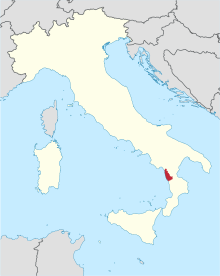Diocese of San Marco Argentano-Scalea
|
Diocese of San Marco Argentano-Scalea Dioecesis Sancti Marci Argentanensis-Scaleensis |
|
|---|---|

Cathedral in San Marco Argentano
|
|
| Location | |
| Country | Italy |
| Ecclesiastical province | Cosenza-Bisignano |
| Statistics | |
| Area | 1,148 km2 (443 sq mi) |
| Population - Total - Catholics |
(as of 2014) 115,600 (est.) 112,600 (est.) (97.4%%) |
| Parishes | 64 |
| Information | |
| Denomination | Roman Catholic |
| Rite | Latin Rite |
| Established | 1179 |
| Cathedral | Cathedral of St. Nicholas |
| Patron saint | Mark the Evangelist |
| Secular priests | 74 (diocesan) 2 (Religious Orders) |
| Current leadership | |
| Pope | Francis |
| Bishop | Leonardo Antonio Paolo Bonanno |
| Metropolitan Archbishop | Salvatore Nunnari |
| Emeritus Bishops | Augusto Lauro |
| Map | |
 |
|
| Website | |
| Diocesan web site (in Italian) | |
The Italian Catholic Diocese of San Marco Argentano-Scalea, in Cosenza, Calabria, has existed as the diocese of San Marco since at least 1171, when the name of Bishop Ruben appears in a document. It is now a suffragan of the Archdiocese of Cosenza-Bisignano.
The historical Diocese of San Marco was created in the twelfth century, out of the remains of the diocese of Malvito. From its beginning, the diocese of San Marco was directly dependent on the Roman See, and was not (unlike Malvito) part of any metropolitan province.
Bishop Ruben (Radulfus Melfensis) of San Marco was present at the III Lateran Council of 1179, signing last among the bishops directly dependent upon the Holy See.
In April 1275, Pope Gregory X, who had completed the II Council of Lyon and was still in Lyon organizing the next Crusade, was impelled to issue a mandate to the Archbishop of Capua to investigate the situation of the Church of San Marco, which was involved in a constested episcopal election. The Pope's stated causa (reason for acting) was that the diocese was attached to the Roman Church, ad Romanam ecclesiam nullo medio spectare dignoscitur. In other words, Pope Gregory was the immediate ecclesiastical superior, with no other authority intervening, not even a metropolitan archbishop.
The seminary of San Marco was established by Bishop Giovanni Antonio Grignetti (1578–1585), in accordance with the decrees of the Council of Trent. The new seminary buildings were built by Bishop Greco in the nineteenth century. Up until the mid-eighteenth century, the seminaries were simple schools of grammar, practical mathematics, ecclesiastical computations, Christian doctrine (as prescribed by Roberto Bellarmine), and Gregorian chant.
In 1818, in accordance with the terms of the Concordat between the Holy See and the Kingdom of the Two Sicilies, the diocese of San Marco was combined with the diocese of Bisignano, becoming the diocese of San Marco e Bisignano and was ranked as immediately subject to the Holy See. In 1834 the territory of Cetraro on the Tyrrhenian coast was added to the diocese of San Marco e Bisignano. Certraro had been founded as a monastery by Robert Guiscard and his wife Sigelgaita and given to the Monastery of Montecassino in 1086; its first abbot was Desiderius, who became Pope Victor III. Since Cetraro was too far distant from Montecassino for effective administration, the Benedictines of Montecassino had assigned the administration of Cetraro to the bishops of San Marco. In 1411 Pope Gregory XII sold Cetraro to King Ladislaus of Naples.
...
Wikipedia
